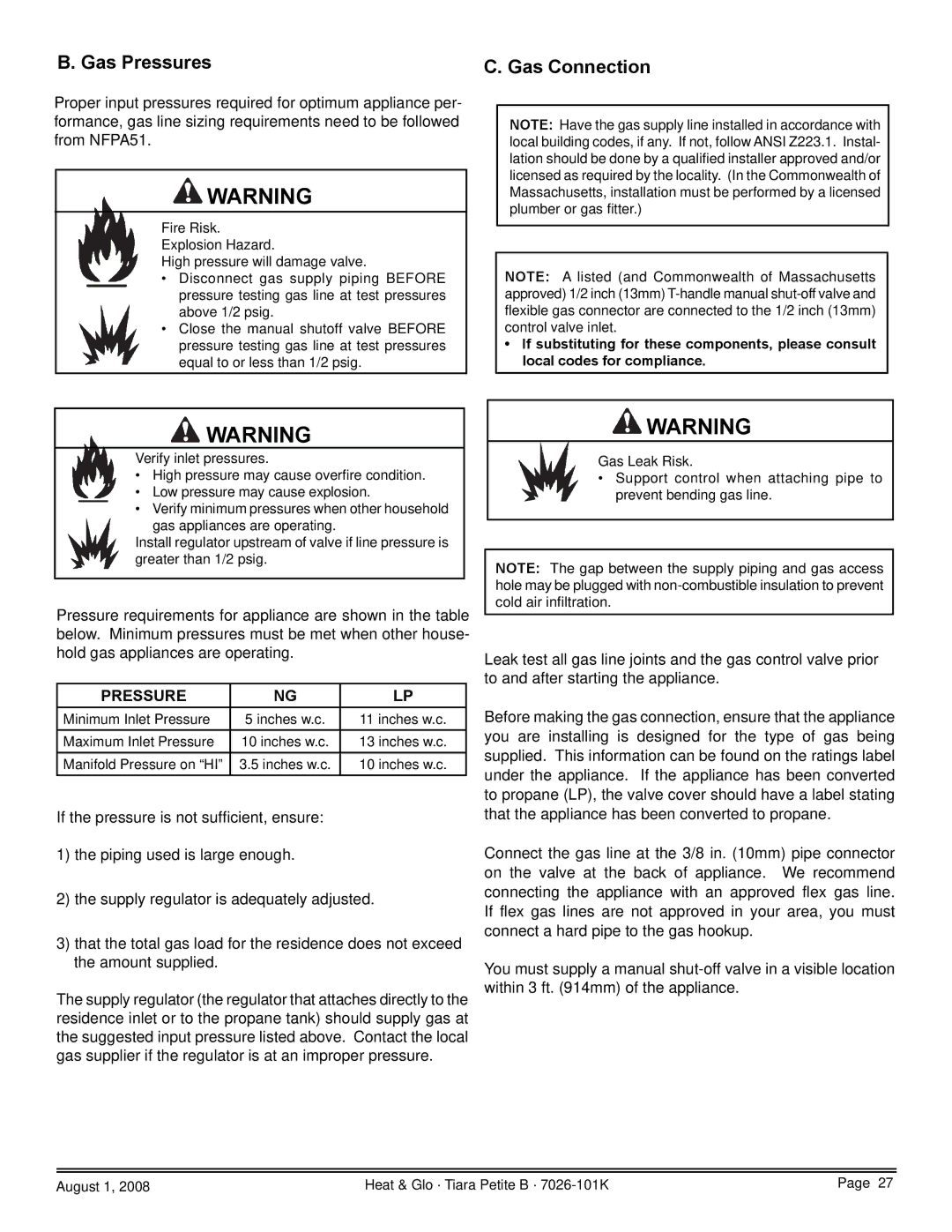
B. Gas Pressures
Proper input pressures required for optimum appliance per- formance, gas line sizing requirements need to be followed from NFPA51.
![]() WARNING
WARNING
Fire Risk.
Explosion Hazard.
High pressure will damage valve.
•Disconnect gas supply piping BEFORE pressure testing gas line at test pressures above 1/2 psig.
• Close the manual shutoff valve BEFORE pressure testing gas line at test pressures equal to or less than 1/2 psig.
C. Gas Connection
NOTE: Have the gas supply line installed in accordance with local building codes, if any. If not, follow ANSI Z223.1. Instal- lation should be done by a qualified installer approved and/or licensed as required by the locality. (In the Commonwealth of Massachusetts, installation must be performed by a licensed plumber or gas fitter.)
NOTE: A listed (and Commonwealth of Massachusetts approved) 1/2 inch (13mm)
•If substituting for these components, please consult local codes for compliance.
![]() WARNING
WARNING
Verify inlet pressures.
•High pressure may cause overfire condition.
•Low pressure may cause explosion.
•Verify minimum pressures when other household gas appliances are operating.
Install regulator upstream of valve if line pressure is greater than 1/2 psig.
Pressure requirements for appliance are shown in the table below. Minimum pressures must be met when other house- hold gas appliances are operating.
PRESSURE | NG | LP |
Minimum Inlet Pressure | 5 inches w.c. | 11 inches w.c. |
Maximum Inlet Pressure | 10 inches w.c. | 13 inches w.c. |
Manifold Pressure on “HI” | 3.5 inches w.c. | 10 inches w.c. |
If the pressure is not sufficient, ensure:
1)the piping used is large enough.
2)the supply regulator is adequately adjusted.
3)that the total gas load for the residence does not exceed the amount supplied.
The supply regulator (the regulator that attaches directly to the residence inlet or to the propane tank) should supply gas at the suggested input pressure listed above. Contact the local gas supplier if the regulator is at an improper pressure.
![]() WARNING
WARNING
Gas Leak Risk.
•Support control when attaching pipe to prevent bending gas line.
NOTE: The gap between the supply piping and gas access hole may be plugged with
Leak test all gas line joints and the gas control valve prior to and after starting the appliance.
Before making the gas connection, ensure that the appliance you are installing is designed for the type of gas being supplied. This information can be found on the ratings label under the appliance. If the appliance has been converted to propane (LP), the valve cover should have a label stating that the appliance has been converted to propane.
Connect the gas line at the 3/8 in. (10mm) pipe connector on the valve at the back of appliance. We recommend connecting the appliance with an approved flex gas line. If flex gas lines are not approved in your area, you must connect a hard pipe to the gas hookup.
You must supply a manual
August 1, 2008 | Heat & Glo · Tiara Petite B · | Page 27 |
